Learning and Development in Entrepreneurial Era: Mapping Research Trends and Future Directions
Abstract
1. Introduction
1.1. Objective of the Study
1.2. Novelty of the Study
1.3. Research Inquiries
- RQ1. What are the current trends in learning and development strategies within the entrepreneurial era?
- RQ2. How are learning and development initiatives distributed across various regions, and which regions lead in terms of impact and adoption?
- RQ3. Which educational platforms and journals are most relevant in the field of learning and development for entrepreneurship?
- RQ4. Who are the most influential thought leaders in the integration of learning and development mechanisms into entrepreneurial practices?
- RQ5. Which are the most impactful studies and articles in the realm of entrepreneurial learning and development?
- RQ6. What is the intellectual structure of current research on learning and development in the entrepreneurial era?
- RQ7. What themes related to learning and development are most popular among scholars in entrepreneurial contexts?
- RQ8. Which areas in learning and development for entrepreneurship require further investigation and refinement?
2. Methodology of the Study
2.1. Research Methodology Approaches
2.2. Strategy for Conducting the Search
3. Data and Results
3.1. Publication Trends over the Years
3.2. Global Distribution of Publications by Region
3.3. Notable Journals
3.4. Researchers and Contributors
3.5. Notable Publications
3.6. Co-Occurrence of Keywords
3.7. Analysis of Keyword Trends
4. Discussion (Present and Future Trends: Cluster Analysis)
4.1. Cluster 1 (Red Color: Entrepreneurship Education and Learning)
4.2. Cluster 2 (Green Color: Entrepreneurial Intention)
4.3. Cluster 3 (Blue Color: Social Entrepreneurship)
4.4. Cluster 4 (Yellow Color: Mentoring Entrepreneur)
4.5. Cluster 5 (Purple Color: Entrepreneurship and Entrepreneurial Failure)
4.6. Cluster 6 (Light Blue Color: Innovation in Entrepreneurship)
5. Conclusions
Author Contributions
Funding
Conflicts of Interest
References
- Abu Anzeh, A. Y., Basel Abushaweesh, Q., Alfayez, M., & AlQudah, M. Z. (2024). Mapping the future information systems and marketing strategy: A bibliometric analysis of emerging trends. EDPACS, 69(10), 1–29. [Google Scholar] [CrossRef]
- Abu Orabi, T., Almasarweh, M. S., Qteishat, M. K., Qudah, H. A., & AlQudah, M. Z. (2024). Mapping leadership and organizational commitment trends: A bibliometric review. Administrative Sciences, 14(8), 171. [Google Scholar] [CrossRef]
- Ahmed, T., Chandran, V. G. R., Klobas, J. E., Liñán, F., & Kokkalis, P. (2020). Entrepreneurship education programmes: How learning, inspiration, and resources affect intentions for new venture creation in a developing economy. The International Journal of Management Education, 18(1), 100327. [Google Scholar] [CrossRef]
- Al Karabsheh, F. I., Abuorabi, Y. K., Abdul Kareem Abu Shaqra, K. T., & AlQudah, M. Z. (2024). Quantifying the evolution of IT audit and control practices: A bibliometric approach. EDPACS, 69(8), 1–20. [Google Scholar] [CrossRef]
- Alqudah, H., Al Qudah, M. Z., Abu Huson, Y., Lutfi, A., Alrawad, M., & Almaiah, M. A. (2024). A decade of green economic literature: An analysis-based bibliometric. International Journal of Energy Economics and Policy, 14(3), 497–511. [Google Scholar] [CrossRef]
- Alqudah, M., Ferruz, L., Martín, E., Qudah, H., & Hamdan, F. (2023). The sustainability of investing in cryptocurrencies: A bibliometric analysis of research trends. International Journal of Financial Studies, 11(3), 93. [Google Scholar] [CrossRef]
- AlQudah, M. Z., Samara, H., Qudah, H., Nazzal, R., Yousef Bani Hani, L., Radwan, R. A., & Alrahamneh, S. (2024a). Financial technology’s role in advancing social responsibility: A bibliometric review of research progress and future opportunities. International Journal of Law and Management. ahead-of-print. [Google Scholar] [CrossRef]
- AlQudah, M. Z., Shatnawi, A., Samara, H., Ghasawneh, D., Al_Majali, R. T., & Al-Rahamneh, A. (2024b). Digital technologies in business education: A hybrid literature review from the Web of Science database. On the Horizon: The International Journal of Learning Futures. ahead-of-print. [Google Scholar]
- Archambault, I., Janosz, M., Fallu, J. S., & Pagani, L. S. (2009). Student engagement and its relationship with early high school dropout. Journal of adolescence, 32(3), 651–670. [Google Scholar] [CrossRef]
- Bhagavatula, S., Elfring, T., Van Tilburg, A., & Van De Bunt, G. G. (2010). How social and human capital influence opportunity recognition and resource mobilization in India’s handloom industry. Journal of Business Venturing, 25(3), 245–260. [Google Scholar] [CrossRef]
- Bhattacharya, S., Momaya, K. S., & Iyer, K. C. (2020). Benchmarking enablers to achieve growth performance: A conceptual framework. Benchmarking: An International Journal, 27(4), 1475–1501. [Google Scholar] [CrossRef]
- Busch, C., & Barkema, H. (2021). From necessity to opportunity: Scaling bricolage across resource-constrained environments. Strategic Management Journal, 42(4), 741–773. [Google Scholar] [CrossRef]
- Cobo, M. J., López-Herrera, A. G., Herrera-Viedma, E., & Herrera, F. (2011). Science mapping software tools: Review, analysis, and cooperative study among tools. Journal of the American Society for Information Science and Technology, 62(7), 1382–1402. [Google Scholar] [CrossRef]
- Cohen, S. L., Bingham, C. B., & Hallen, B. L. (2019). The role of accelerator designs in mitigating bounded rationality in new ventures. Administrative Science Quarterly, 64(4), 810–854. [Google Scholar] [CrossRef]
- Cui, J., & Bell, R. (2022). Behavioural entrepreneurial mindset: How entrepreneurial education activity impacts entrepreneurial intention and behaviour. The International Journal of Management Education, 20(2), 100639. [Google Scholar] [CrossRef]
- Dimov, D. (2007). From opportunity insight to opportunity intention: The importance of person–situation learning match. Entrepreneurship Theory and Practice, 31(4), 561–583. [Google Scholar] [CrossRef]
- Dissanayake, H., Iddagoda, A., & Popescu, C. (2022). Entrepreneurial education at universities: A bibliometric analysis. Administrative Sciences, 12(4), 185. [Google Scholar] [CrossRef]
- Downing, S. (2005). The social construction of entrepreneurship: Narrative and dramatic processes in the coproduction of organizations and identities. Entrepreneurship Theory and Practice, 29(2), 185–204. [Google Scholar] [CrossRef]
- Drayton, W. (2002). The citizen sector: Becoming as entrepreneurial and competitive as business. California Management Review, 44(3), 120–132. [Google Scholar] [CrossRef]
- Duchek, S. (2018). Entrepreneurial resilience: A biographical analysis of successful entrepreneurs. International Entrepreneurship and Management Journal, 14(2), 429–455. [Google Scholar] [CrossRef]
- Edwards-Schachter, M., & Wallace, M. L. (2017). ‘Shaken, but not stirred’: Sixty years of defining social innovation. Technological Forecasting and Social Change, 119, 64–79. [Google Scholar] [CrossRef]
- Fiore, E., Sansone, G., & Paolucci, E. (2019). Entrepreneurship education in a multidisciplinary environment: Evidence from an entrepreneurship programme held in Turin. Administrative Sciences, 9(1), 28. [Google Scholar] [CrossRef]
- Gouveia, S., de la Iglesia, D. H., Abrantes, J. L., & López Rivero, A. J. (2024). Transforming strategy and value creation through digitalization? Administrative Sciences, 14(11), 307. [Google Scholar] [CrossRef]
- Harrison, R. T., & Leitch, C. M. (2005). Entrepreneurial learning: Researching the interface between learning and the entrepreneurial context. Entrepreneurship Theory and Practice, 29(4), 351–371. [Google Scholar] [CrossRef]
- Herbane, B. (2019). Rethinking organizational resilience and strategic renewal in SMEs. Entrepreneurship & Regional Development, 31(5–6), 476–495. [Google Scholar]
- Hoppe, M. (2016). Policy and entrepreneurship education. Small Business Economics, 46(1), 13–29. [Google Scholar] [CrossRef]
- Kaminski, J. C., & Hopp, C. (2020). Predicting outcomes in crowdfunding campaigns with textual, visual, and linguistic signals. Small Business Economics, 55(3), 627–649. [Google Scholar] [CrossRef]
- Kassean, H., Vanevenhoven, J., Liguori, E., & Winkel, D. E. (2015). Entrepreneurship education: A need for reflection, real-world experience and action. International Journal of Entrepreneurial Behavior & Research, 21(5), 690–708. [Google Scholar]
- Koe Hwee Nga, J., & Shamuganathan, G. (2010). The influence of personality traits and demographic factors on social entrepreneurship start-up intentions. Journal of Business Ethics, 95, 259–282. [Google Scholar] [CrossRef]
- Lerner, M., Brush, C., & Hisrich, R. (1997). Israeli women entrepreneurs: An examination of factors affecting performance. Journal of Business Venturing, 12(4), 315–339. [Google Scholar] [CrossRef]
- Liu, Y., & Zhang, H. (2022). Driving sustainable innovation in new ventures: A study based on the fsQCA approach. Sustainability, 14(9), 5738. [Google Scholar] [CrossRef]
- Momani, M. A. K. A., Alharahasheh, K. A., & Alqudah, M. (2023). Digital learning in sciences education: A literature review. Cogent Education, 10(2), 2277007. [Google Scholar] [CrossRef]
- Nicholls-Nixon, C. L., Cooper, A. C., & Woo, C. Y. (2000). Strategic experimentation: Understanding change and performance in new ventures. Journal of Business Venturing, 15(5–6), 493–521. [Google Scholar] [CrossRef]
- Nicolopoulou, K., Karataş-Özkan, M., Vas, C., & Nouman, M. (2017). An incubation perspective on social innovation: The London Hub–a social incubator. R&D Management, 47(3), 368–384. [Google Scholar]
- Pangriya, R., & Pandey, S. (2024). Development in rural entrepreneurship and future scope of research: A bibliometric analysis. Journal of Global Entrepreneurship Research, 14(1), 27. [Google Scholar] [CrossRef]
- Qabajeh, M., Qubbaja, A., Jebreel, M., Zakaria AlQudah, M., & Salim Faiq Alkhatib, F. (2024). Trends and patterns in coso-related auditing research: A bibliometric study. EDPACS, 69(10), 30–53. [Google Scholar] [CrossRef]
- Qudah, H., Baqila, B. K. A., Albadienah, J. M. O., AlQudah, M. Z., Al Qudah, S., Alrahamneh, S., Ababne, A., & Qudah, I. (2024). Using bibliometrics to understand algorithmic finance. Journal of Applied Economics, 27(1), 2389497. [Google Scholar] [CrossRef]
- Qudah, H., Malahim, S., Airout, R., Alomari, M., Hamour, A. A., & Alqudah, M. (2023). Islamic finance in the era of financial technology: A bibliometric review of future trends. International Journal of Financial Studies, 11(2), 76. [Google Scholar] [CrossRef]
- Ravasi, D., & Turati, C. (2005). Exploring entrepreneurial learning: A comparative study of technology development projects. Journal of Business Venturing, 20(1), 137–164. [Google Scholar] [CrossRef]
- Samara, H. H., Qudah, H. A., Mohsin, H. J., Abualhijad, S., Bani Hani, L. Y., Al Rahamneh, S., & AlQudah, M. Z. (2024). Artificial intelligence and machine learning in corporate governance: A bibliometric analysis. Human Systems Management, 1–27. [Google Scholar] [CrossRef]
- Secundo, G., Gioconda, M. E. L. E., Del Vecchio, P., Gianluca, E. L. I. A., Margherita, A., & Valentina, N. D. O. U. (2021). Threat or opportunity? A case study of digital-enabled redesign of entrepreneurship education in the COVID-19 emergency. Technological Forecasting and Social Change, 166, 120565. [Google Scholar] [CrossRef]
- Shepherd, D. A., Covin, J. G., & Kuratko, D. F. (2009). Project failure from corporate entrepreneurship: Managing the grief process. Journal of Business Venturing, 24(6), 588–600. [Google Scholar] [CrossRef]
- Shepherd, D. A., & Gruber, M. (2021). The lean startup framework: Closing the academic–practitioner divide. Entrepreneurship Theory and Practice, 45(5), 967–998. [Google Scholar] [CrossRef]
- Shepherd, D. A., Patzelt, H., Williams, T. A., & Warnecke, D. (2014). How does project termination impact project team members? Rapid termination, ‘creeping death’, and learning from failure. Journal of Management Studies, 51(4), 513–546. [Google Scholar] [CrossRef]
- Tiberius, V., Rietz, M., & Bouncken, R. B. (2020). Performance analysis and science mapping of institutional entrepreneurship research. Administrative Sciences, 10(3), 69. [Google Scholar] [CrossRef]
- Van Eck, N. J., & Waltman, L. (2011). VOSviewer manual. Manual for VOSviewer Version, 1, 1–27. [Google Scholar]
- Vlas, C. O., de Góes, B. B., Vlas, R. E., & See, E. (2024). Competing in innovation-intensive environments: The role of soft power, learning, and CEO heuristics. Administrative Sciences, 14(8), 169. [Google Scholar] [CrossRef]
- Zacharakis, A. L., & Meyer, G. D. (1998). A lack of insight: Do venture capitalists really understand their own decision process? Journal of Business Venturing, 13(1), 57–76. [Google Scholar] [CrossRef]
- Zozimo, R., Jack, S., & Hamilton, E. (2017). Entrepreneurial learning from observing role models. Entrepreneurship & Regional Development, 29(9–10), 889–911. [Google Scholar]

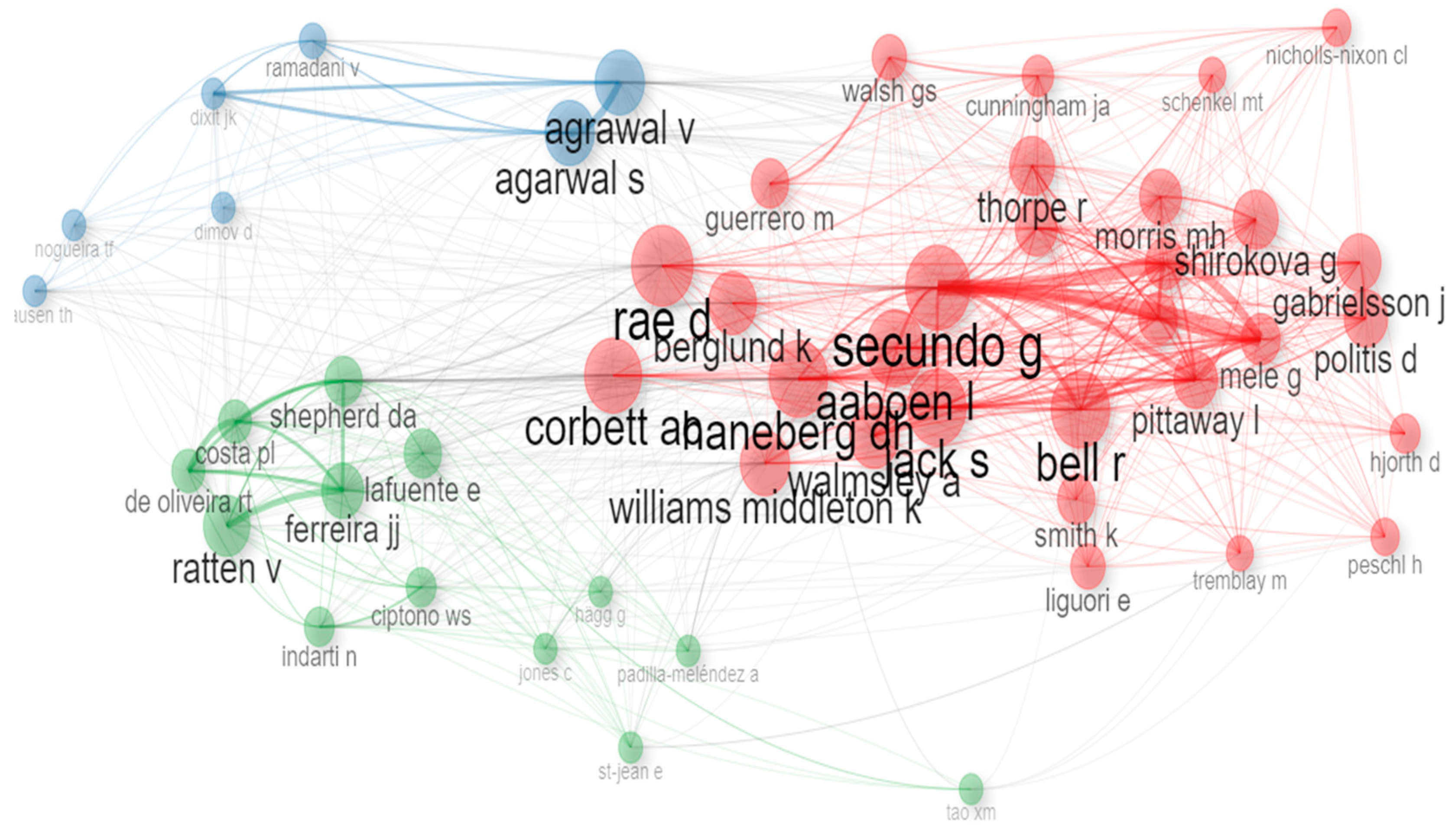

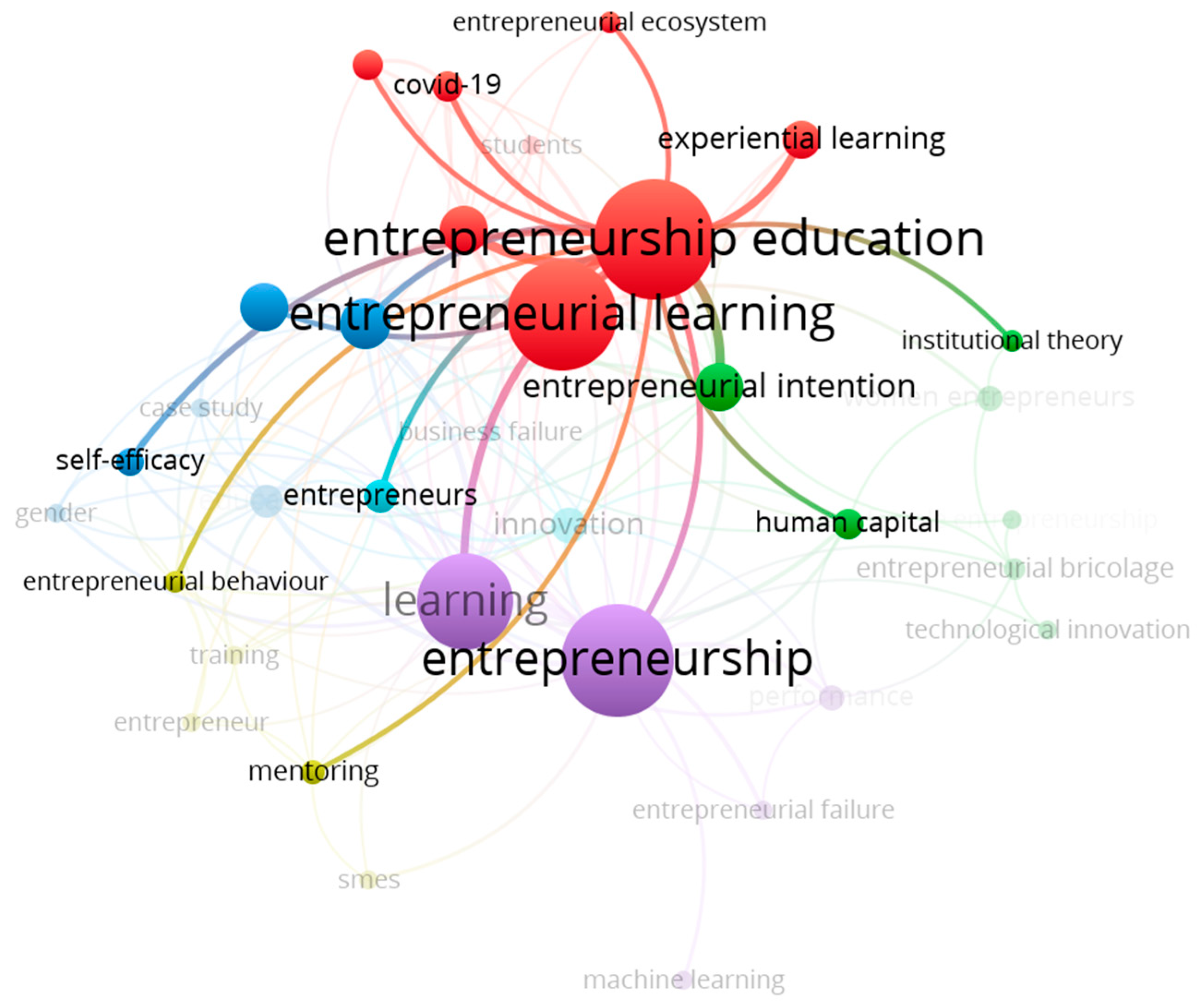
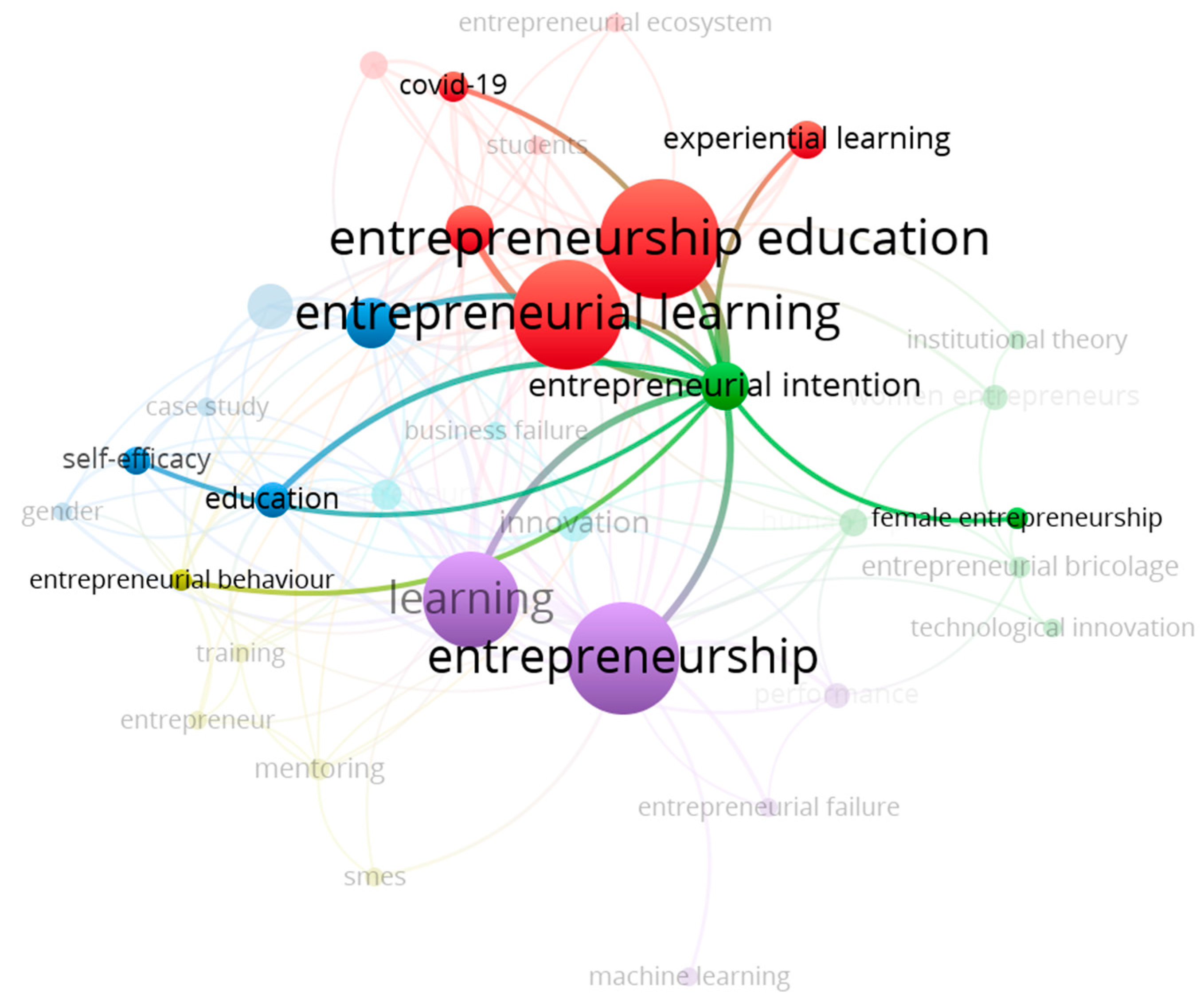
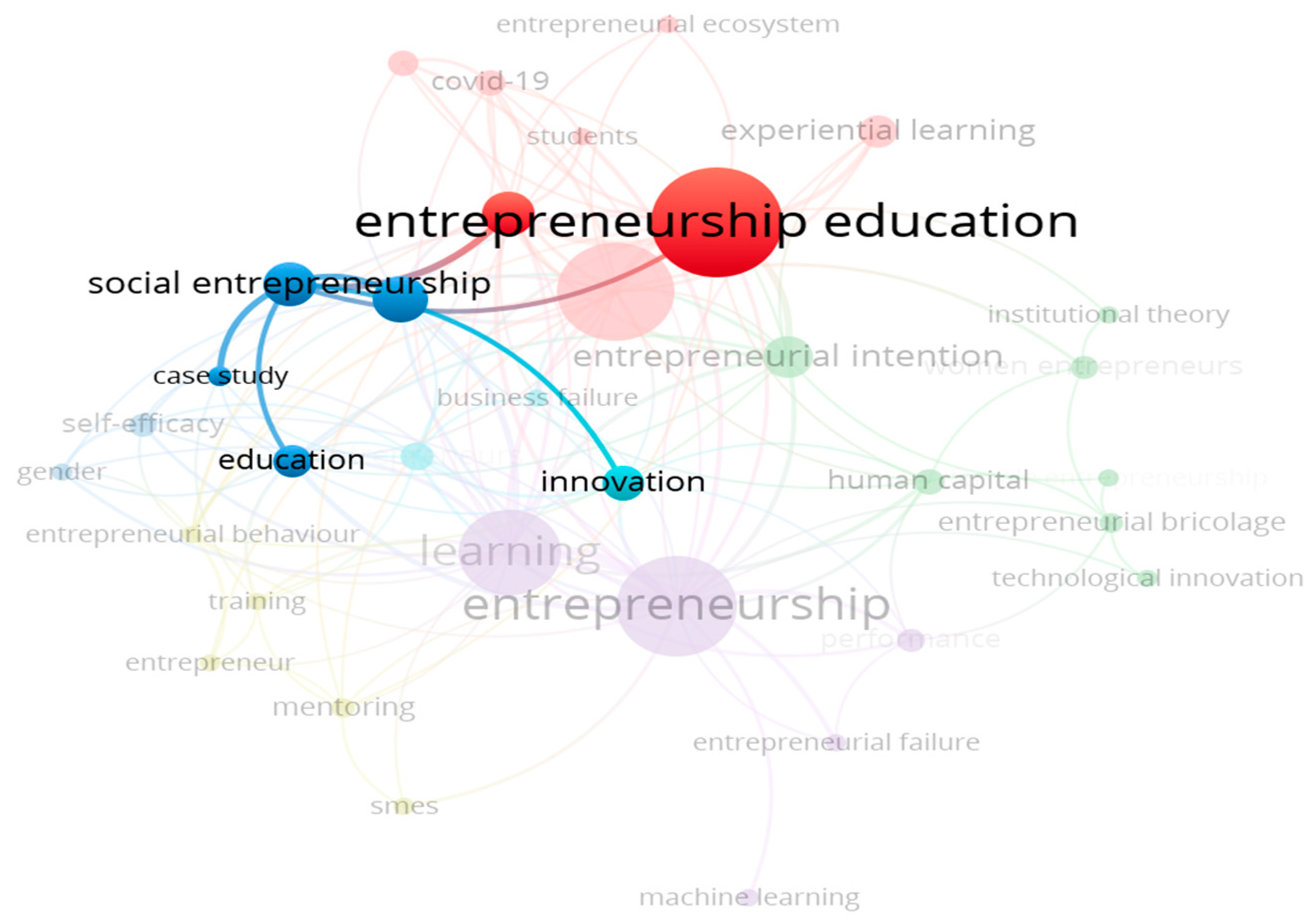
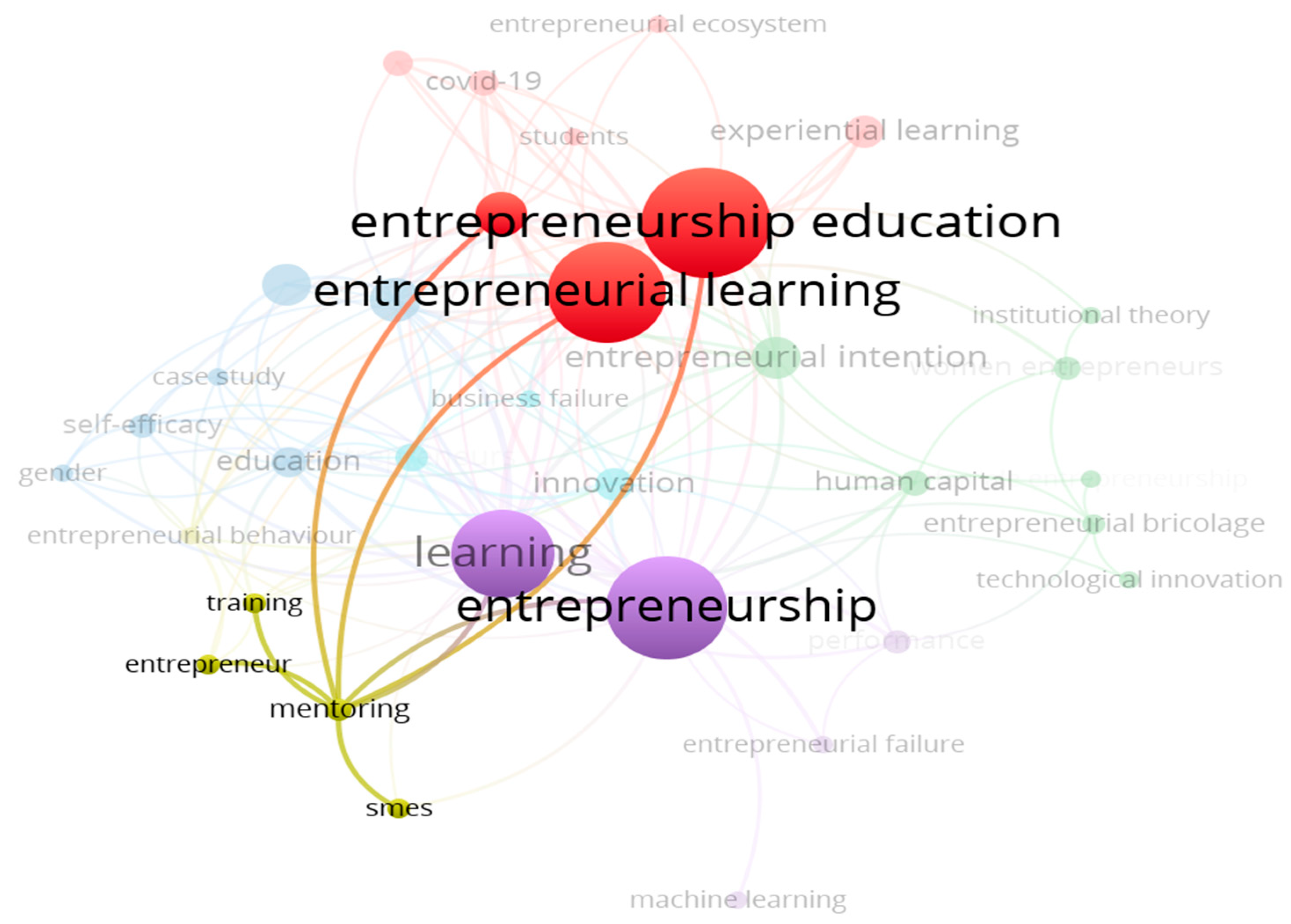

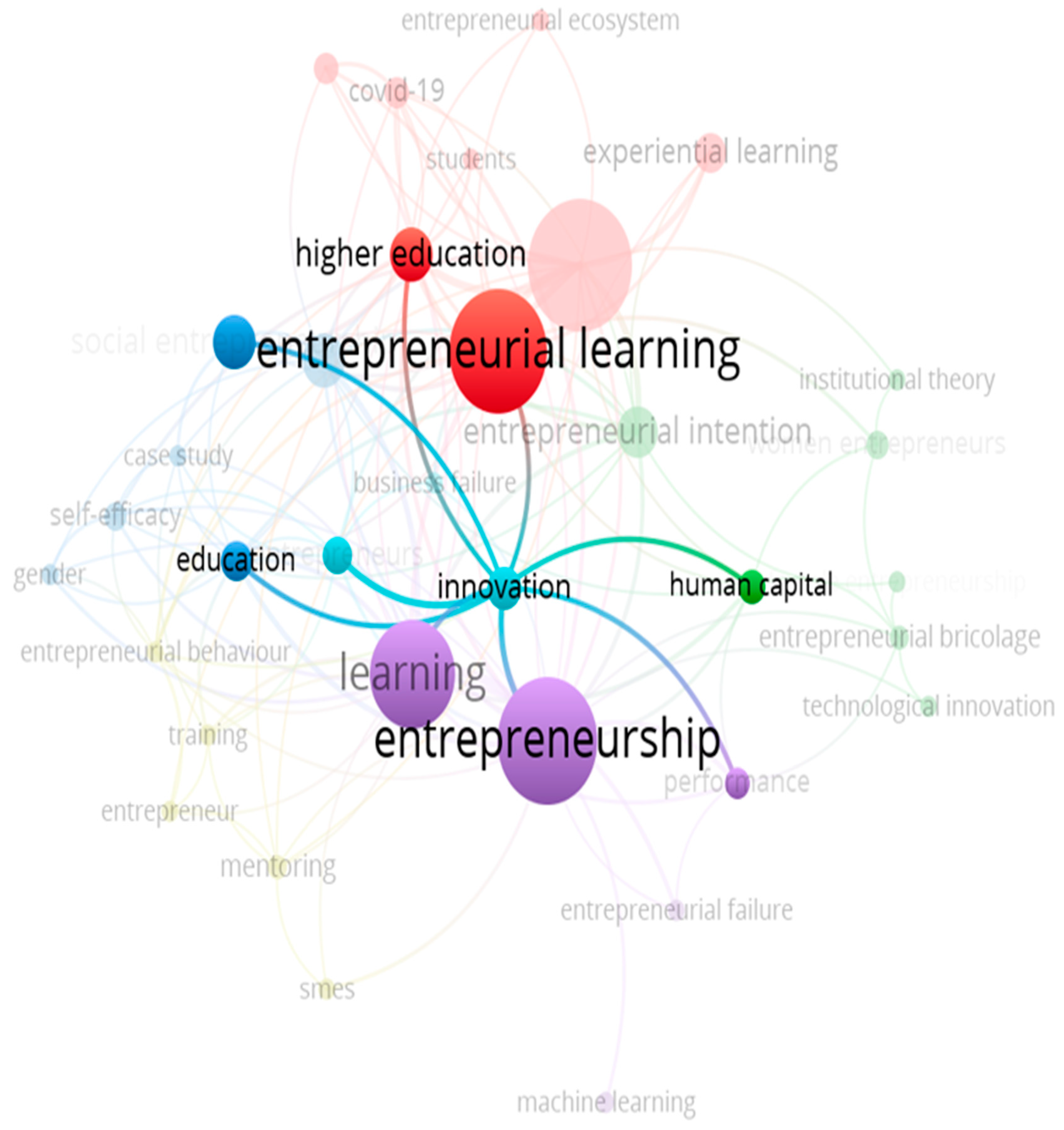
| Basis of Comparison | Study 1: Dissanayake et al. (2022) | Study 2: Pangriya and Pandey (2024) | Our Study |
|---|---|---|---|
| Purpose | To analyze entrepreneurial education at universities globally | To analyze rural entrepreneurship and future research scope | To explore learning and development in the entrepreneurial era, focusing on both university and rural entrepreneurship |
| Focus of the Study | Entrepreneurship education, themes, and dynamics at universities | Rural entrepreneurship, research trends, and thematic analysis | Entrepreneurial education and learning in universities, rural entrepreneurship, and development trends |
| Keywords | Entrepreneurship education, universities, bibliometric analysis | Rural entrepreneurship, thematic analysis, research trends | Learning and development, entrepreneurial education, rural entrepreneurship |
| Time Period | 2004–2022 | 2002–2022 | 1994–2024 |
| Methodology | Bibliometric analysis, review of 447 studies | Bibliometric and thematic analysis of 220 studies | Bibliometric and cluster analysis of 354 studies, focusing on trends in education and rural entrepreneurship |
| Date | Database | Search Query | First Stage Filters | Initial Results | Second Stage Filters | Filtered Results |
|---|---|---|---|---|---|---|
| 31st December 2024 | Web of Science Core Collection | Entrepreneurial education and development | Document Type: Article; Language: English | 558 journal articles in English | Subject area filters applied: Education; Business and Management; Entrepreneurship; Innovation | 354 articles from relevant subject areas |
| Description | Results |
|---|---|
| Timespan | 1994:2024 |
| Sources (Journals; Books; etc.) | 97 |
| Documents | 354 |
| Annual Growth Rate (%) | 5.33 |
| Document Average Age | 5.74 years |
| Average Citations per Document | 28.08 |
| References | 21,029 |
| Keywords Plus (ID) | 788 |
| Author’s Keywords (DE) | 1132 |
| Authors | 943 |
| Authors of Single-Authored Docs | 38 |
| Single-Authored Docs | 39 |
| Co-Authors per Document | 2.92 |
| International Co-Authorships (%) | 36.72 |
| Document Types | Articles (354) |
| Serial No. | Country | Total Publication |
|---|---|---|
| 1 | United Kingdom | 62 |
| 2 | USA | 43 |
| 3 | China | 28 |
| 4 | Sweden | 18 |
| 5 | Canada | 14 |
| 6 | Spain | 14 |
| 7 | India | 12 |
| 8 | Australia | 11 |
| 9 | Norway | 11 |
| 10 | Germany | 10 |
| Country | TC | Average Article Citations | SCP | MCP | MCP Ratio |
|---|---|---|---|---|---|
| United Kingdom | 1878 | 30.30 | 40 | 22 | 0.355 |
| USA | 1820 | 42.30 | 28 | 15 | 0.349 |
| Canada | 541 | 38.60 | 9 | 5 | 0.357 |
| Sweden | 531 | 29.50 | 10 | 8 | 0.444 |
| Italy | 406 | 40.60 | 8 | 2 | 0.2 |
| China | 399 | 14.20 | 22 | 6 | 0.214 |
| Spain | 371 | 26.50 | 11 | 3 | 0.214 |
| India | 301 | 25.10 | 5 | 7 | 0.583 |
| Germany | 233 | 23.30 | 8 | 2 | 0.2 |
| Australia | 160 | 14.50 | 4 | 7 | 0.636 |
| Serial No. | Affiliation (Country) | Total Publications |
|---|---|---|
| 1 | Coventry University (UK) | 6 |
| 2 | University System of Ohio (USA) | 6 |
| 3 | University of North Carolina (USA) | 5 |
| 4 | De Montfort University (UK) | 5 |
| 5 | Austral University (Australia) | 4 |
| 6 | Glasgow Caledonian University (UK) | 4 |
| 7 | Indiana University Bloomington (USA) | 4 |
| 8 | King Faisal University (Saudi Arabia) | 4 |
| 9 | Lancaster University (UK) | 4 |
| 10 | Laval University (Canada) | 4 |
| Journals | H Index | G Index | M Index | TC | TP | Publication Starts |
|---|---|---|---|---|---|---|
| Entrepreneurship and Regional Development | 20 | 32 | 0.8 | 1301 | 32 | 2001 |
| International Journal of Entrepreneurial Behavior & Research | 18 | 30 | 1.2 | 999 | 47 | 2011 |
| International Journal of Management Education | 10 | 22 | 1.111 | 501 | 31 | 2017 |
| Journal of Business Venturing | 10 | 13 | 0.323 | 1431 | 13 | 1995 |
| Journal of Small Business and Enterprise Development | 10 | 16 | 1.667 | 258 | 23 | 2020 |
| The International Small Business Journal | 9 | 10 | 0.409 | 400 | 10 | 2004 |
| International Entrepreneurship and Management Journal | 8 | 13 | 0.533 | 451 | 13 | 2011 |
| Small Business Economics | 8 | 14 | 0.25 | 431 | 14 | 1994 |
| Entrepreneurship Theory and Practice | 7 | 7 | 0.333 | 1053 | 7 | 2005 |
| Journal of Business Research | 7 | 9 | 0.538 | 189 | 9 | 2013 |
| Authors | H Index | G Index | M Index | TC | TP | Publication Starts |
|---|---|---|---|---|---|---|
| Secundo G | 5 | 5 | 0.556 | 226 | 5 | 2017 |
| Jack S | 4 | 4 | 0.286 | 173 | 4 | 2012 |
| Shepherd Da | 4 | 5 | 0.235 | 419 | 5 | 2009 |
| Del Vecchio P | 3 | 3 | 0.333 | 199 | 3 | 2017 |
| Hamilton E | 3 | 3 | 0.214 | 171 | 3 | 2012 |
| Haneberg Dh | 3 | 4 | 0.6 | 51 | 4 | 2021 |
| Indarti N | 3 | 3 | 1 | 27 | 3 | 2023 |
| Mele G | 3 | 3 | 0.6 | 159 | 3 | 2021 |
| Nicholls-Nixon Cl | 3 | 3 | 0.115 | 184 | 3 | 2000 |
| Passiante G | 3 | 3 | 0.333 | 103 | 3 | 2017 |
| Serial No. | Authors (Years) | Title | TC | Source Title |
|---|---|---|---|---|
| 1 | Koe Hwee Nga and Shamuganathan (2010) | The influence of personality traits and demographic factors on social entrepreneurship start-up intentions | 405 | Journal of Business Ethics |
| 2 | Downing (2005) | The social construction of entrepreneurship: Narrative and dramatic processes in the coproduction of organizations and identities | 281 | Entrepreneurship Theory and Practice |
| 3 | Zacharakis and Meyer (1998) | A lack of insight: Do venture capitalists really understand their own decision process? | 250 | Journal of Business Venturing |
| 4 | Dimov (2007) | From opportunity insight to opportunity intention: The importance of person–situation learning match | 242 | Entrepreneurship Theory and Practice |
| 5 | Lerner et al. (1997) | Israeli women entrepreneurs: An examination of factors affecting performance | 236 | Journal of Business Venturing |
| 6 | Bhagavatula et al. (2010) | How social and human capital influence opportunity recognition and resource mobilization in India’s handloom industry | 235 | Journal of Business Venturing |
| 7 | Harrison and Leitch (2005) | Entrepreneurial learning: Researching the interface between learning and the entrepreneurial context | 209 | Entrepreneurship Theory and Practice |
| 8 | Kassean et al. (2015) | Entrepreneurship education: A need for reflection; real-world experience and action | 206 | International Journal of Entrepreneurial Behavior & Research |
| 9 | Drayton (2002) | The citizen sector: Becoming as entrepreneurial and competitive as business | 205 | California Management Review |
| 10 | Edwards-Schachter and Wallace (2017) | ‘Shaken; but not stirred’: Sixty years of defining social innovation | 183 | Technological Forecasting and Social Change |
| Serial No. | Keyword | Frequency |
|---|---|---|
| 1 | Entrepreneurship Education | 48 |
| 2 | Entrepreneurship | 44 |
| 3 | Entrepreneurial Learning | 43 |
| 4 | Learning | 36 |
| 5 | Entrepreneurial Education | 16 |
| 6 | Entrepreneurial Intention | 15 |
| 7 | Higher Education | 15 |
| 8 | Social Entrepreneurship | 15 |
| 9 | Experiential Learning | 11 |
| 10 | Innovation | 11 |
| 11 | Education | 10 |
| 12 | Entrepreneurs | 9 |
| 13 | COVID-19 | 8 |
| 14 | Effectuation | 8 |
| 15 | Human Capital | 8 |
Disclaimer/Publisher’s Note: The statements, opinions and data contained in all publications are solely those of the individual author(s) and contributor(s) and not of MDPI and/or the editor(s). MDPI and/or the editor(s) disclaim responsibility for any injury to people or property resulting from any ideas, methods, instructions or products referred to in the content. |
© 2025 by the authors. Licensee MDPI, Basel, Switzerland. This article is an open access article distributed under the terms and conditions of the Creative Commons Attribution (CC BY) license (https://creativecommons.org/licenses/by/4.0/).
Share and Cite
Al Sharari, F.E.A.; Almohtaseb, A.a.; Alshaketheep, K.; Al Nawaiseh, K. Learning and Development in Entrepreneurial Era: Mapping Research Trends and Future Directions. Adm. Sci. 2025, 15, 299. https://doi.org/10.3390/admsci15080299
Al Sharari FEA, Almohtaseb Aa, Alshaketheep K, Al Nawaiseh K. Learning and Development in Entrepreneurial Era: Mapping Research Trends and Future Directions. Administrative Sciences. 2025; 15(8):299. https://doi.org/10.3390/admsci15080299
Chicago/Turabian StyleAl Sharari, Fayiz Emad Addin, Ahmad ali Almohtaseb, Khaled Alshaketheep, and Kafa Al Nawaiseh. 2025. "Learning and Development in Entrepreneurial Era: Mapping Research Trends and Future Directions" Administrative Sciences 15, no. 8: 299. https://doi.org/10.3390/admsci15080299
APA StyleAl Sharari, F. E. A., Almohtaseb, A. a., Alshaketheep, K., & Al Nawaiseh, K. (2025). Learning and Development in Entrepreneurial Era: Mapping Research Trends and Future Directions. Administrative Sciences, 15(8), 299. https://doi.org/10.3390/admsci15080299





